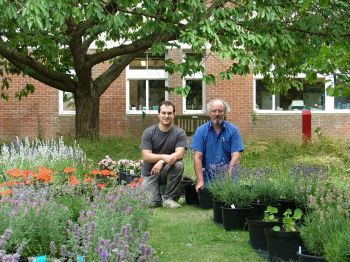Many people feel enthusiastic about helping honey bees in their current decline, but they often do not know how. One way the public can help is by growing bee-friendly plants in their gardens. Accordingly, organisations such as the Royal Horticultural Society and the Bumblebee Conservation Trust have published lists of recommended bee-friendly garden plants. However, these lists are largely based on anecdotes; for example, few people who have grown lavender in their gardens would deny that it is very attractive to bees. The aim of this project is to scientifically assess the value of garden plants to honey bees and other pollinators.
 Mihail Garbuzov and Prof. Francis Ratnieks at the lavender trails plot
Mihail Garbuzov and Prof. Francis Ratnieks at the lavender trails plot
Previous LASI research has shown that late summer and autumn are difficult times for honey bees to find forage, as opposed to spring, when most plants are blooming. Therefore, lavender was chosen for its late flowering period. Fourteen popular varieties of lavender to be tested in this experiment were recommended by Downderry Nursery - holders of the National Lavender Collection and recipients of five gold medals from RHS flower shows. In addition, other common garden plants will be tested, such as geranium, nasturtium, dahlia, borage and others. The results of this experiment will help people make well-informed choices for their bee-friendly gardens, helping not only honey bees, but also bumblebees and other pollinators facing current declines.


